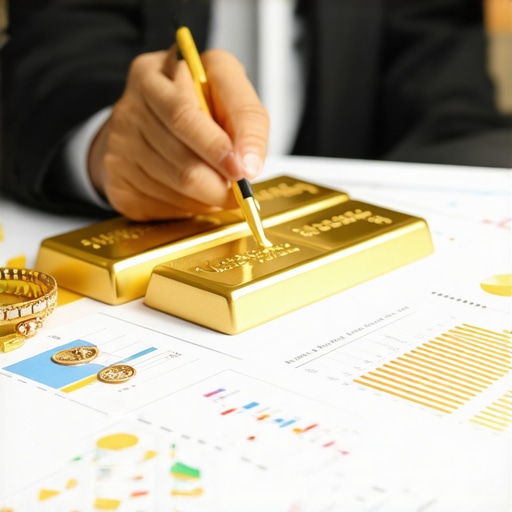Deciphering the Complex Landscape of Gold Demand in 2025: An Expert Analysis
The global gold market in 2025 is characterized by intricate demand patterns shaped by macroeconomic forces, technological innovations, and evolving consumer behaviors. As industry insiders and investors seek nuanced insights, understanding these layered dynamics becomes paramount for strategic decision-making. This article explores the sophisticated interplay between jewelry consumption, technological applications, and industry demand, providing a comprehensive perspective rooted in expert analysis.
How Do Macroeconomic Trends Influence Gold Demand Across Sectors?
Economic indicators such as inflation rates, currency stability, and geopolitical tensions significantly sway gold demand. Central banks continue to optimize their gold reserves, impacting international prices and industry supply chains. Notably, reports from the World Gold Council highlight a sustained increase in central bank gold acquisitions in 2025, underscoring strategic reserve diversification amidst global uncertainties.
Jewelry Sector: Analyzing Consumption Patterns and Cultural Shifts
Jewelry remains the predominant driver of physical gold demand, with emerging markets leading the charge. However, shifts in consumer preferences—favoring sustainable and ethically sourced gold—are redefining industry standards. Advanced insights into regional consumption trends reveal that technological integration in jewelry design, such as 3D printing and blockchain authentication, enhances transparency and consumer trust. For a detailed exploration, see Gold Demand Trends 2025.
Technological Integration: The Role of Gold in Industry and Innovation
Beyond traditional applications, gold’s unique properties—such as excellent conductivity and corrosion resistance—make it indispensable in high-tech industries. The adoption of gold in electronics, renewable energy, and emerging quantum computing technologies signifies a paradigm shift. Industry reports indicate a surge in demand for gold in semiconductor manufacturing, driven by advancements in AI and 5G infrastructure. As the industry experts suggest, this trend underscores gold’s evolving role as a critical component in technological innovation.
Expert Inquiry: What Are the Future Risks and Opportunities in Gold Demand?
How might geopolitical tensions and climate policies alter the trajectory of gold demand in the next decade?
This question reflects ongoing debates among industry analysts. While geopolitical uncertainties tend to boost gold’s appeal as a hedge, evolving climate policies and environmental regulations could impact mining operations and supply chains, introducing volatility. A balanced perspective suggests that diversification strategies, such as investing in gold ETFs or industry stocks, remain prudent. For strategic insights, consider reviewing Gold Demand Trends 2025.
To deepen your expertise, explore our comprehensive guides on safe gold coin investments and top gold ETFs for 2025. Engage with industry forums and contribute your insights to shape future analyses in this dynamic market.
Emerging Technologies and Gold: A New Frontier for Industry Applications
As digital transformation accelerates, gold’s role in cutting-edge technologies becomes increasingly vital. From quantum computing to advanced aerospace engineering, gold’s exceptional conductivity and corrosion resistance make it indispensable. Experts note that demand for gold in high-tech sectors is expected to rise sharply, fueling a shift in how investors and industries view gold as a strategic commodity.
Challenging Conventional Wisdom: Is Gold Still a Reliable Hedge in 2025?
Many assume gold’s traditional role as an inflation hedge remains unchallenged. However, recent market dynamics suggest a more nuanced reality. While gold often performs well during economic uncertainty, its correlation with other assets is complex. The latest economic indicators reveal that geopolitical events and monetary policies can cause short-term volatility. Therefore, diversification strategies, including investments in gold ETFs and mining stocks, are increasingly recommended for resilient portfolios.
How Can Investors Leverage Advanced Analytical Tools to Optimize Gold Investments?
In an era of rapid market evolution, sophisticated analytical frameworks like technical analysis, machine learning models, and real-time data feeds empower investors. These tools facilitate precise timing and risk management, especially in volatile environments. Industry leaders suggest that integrating technical analysis techniques with macroeconomic insights can significantly enhance portfolio performance. To deepen your understanding, explore our detailed guides on trading strategies and safe gold coin investments.
Considering these advanced tools, what innovative approaches might redefine gold investing in the coming years? Share your thoughts below or join industry forums to exchange insights. Stay informed by following updates on gold market analysis and discover emerging opportunities in this dynamic landscape.
Strategic Insights into Gold Demand Dynamics Amidst Global Transformations
As we venture further into 2025, the landscape of gold demand is increasingly shaped by multifaceted factors, including technological revolutions, geopolitical shifts, and sustainability trends. Industry experts emphasize that understanding these interconnected elements is crucial for investors seeking to capitalize on emerging opportunities while mitigating risks. This comprehensive analysis explores how advanced technological integration, evolving consumer preferences, and macroeconomic policies are redefining gold’s role across sectors.
How Are Emerging Technologies Reshaping Gold Utilization in Industry?
Gold’s unparalleled conductivity, malleability, and resistance to corrosion position it as a cornerstone in high-tech applications. From quantum computing hardware to next-generation aerospace components, the demand for refined gold is soaring. Notably, research published by the IEEE Transactions on Components, Packaging and Manufacturing Technology highlights innovations in gold nano-coatings that enhance electronic performance. These developments not only boost efficiency but also open avenues for sustainable manufacturing processes, addressing environmental concerns associated with traditional mining.
What are the potential environmental impacts of increased gold usage in technology, and how can they be mitigated?
While technological advancements amplify gold demand, they also pose environmental challenges, such as increased energy consumption and waste generation. Industry leaders advocate for adopting green mining practices and recycling initiatives, which can significantly reduce environmental footprints. For example, companies leveraging hydrometallurgical extraction methods demonstrate promising reductions in ecological impact, aligning with global sustainability goals.
Regional Consumption Shifts: The Cultural and Economic Drivers
Emerging markets, particularly in Asia and Africa, continue to lead in jewelry consumption, driven by rising disposable incomes and cultural affinity for gold. However, a notable shift is occurring: consumers increasingly favor ethically sourced and environmentally friendly gold. This demand is catalyzing the adoption of blockchain authentication and traceability systems, fostering transparency. According to the World Gold Council’s 2025 report, such innovations are transforming consumer trust and brand loyalty in gold jewelry.

Harnessing Data Analytics and AI for Smarter Gold Investment Strategies
In an era where data-driven decision-making defines industry success, sophisticated analytical tools are indispensable. Machine learning models analyze vast datasets—from macroeconomic indicators to market sentiment—to forecast gold price movements with higher precision. Investors utilizing platforms integrated with real-time analytics gain a competitive edge, adjusting portfolios proactively. For instance, a recent study by Fintech Analytics Journal demonstrates that AI-powered algorithms outperform traditional models in predicting short-term gold price volatility.
What are the limitations of current AI models in predicting gold market fluctuations?
Despite significant advancements, AI models face challenges such as data quality issues, model overfitting, and unforeseen geopolitical shocks. Experts recommend combining AI insights with expert judgment and macroeconomic analysis to navigate these uncertainties effectively. Continuous model validation and incorporating alternative data sources, like social media sentiment, can enhance predictive accuracy.
Future Outlook: Risks, Opportunities, and Strategic Adaptation
Looking ahead, geopolitical tensions and climate policies will remain pivotal in shaping gold demand. While increased tensions tend to elevate gold’s appeal as a safe haven, stringent environmental regulations could constrain supply, leading to price volatility. Strategic diversification—through ETFs, mining stocks, and physical holdings—becomes essential for resilient portfolios. Industry forecasts suggest that integrating sustainable practices into mining and refining processes will not only mitigate risks but also unlock new value chains aligned with global sustainability agendas.
To deepen your understanding of these complex dynamics, explore detailed guides on advanced investment strategies and gold’s role in renewable energy technologies. Engage with industry forums to exchange insights on emerging trends and innovative solutions shaping the future of gold markets.
Beyond the Horizon: How Sustainable Practices Will Shape Gold Demand in 2025
The integration of eco-friendly mining techniques and recycled gold sources is poised to redefine industry standards, fostering a more resilient and ethically aligned supply chain. Experts emphasize that innovations such as hydrometallurgical extraction and closed-loop recycling systems will not only mitigate environmental impacts but also influence market dynamics, potentially stabilizing prices amidst geopolitical uncertainties.
Decoding the Influence of Blockchain on Gold Authentication and Consumer Trust
Blockchain technology is revolutionizing transparency within the gold industry by enabling immutable traceability from mine to market. This digital ledger enhances consumer confidence, particularly in ethically sourced gold sectors, and reduces counterfeit risks. Leading industry reports from the World Gold Council highlight how blockchain adoption correlates with increased demand in high-end jewelry markets.
What are the Cutting-Edge Analytical Tools Transforming Gold Investment Strategies?
Advanced analytics, including AI-driven predictive models and big data analysis, empower investors to navigate complex market fluctuations with unprecedented precision. Platforms integrating machine learning algorithms analyze macroeconomic indicators, geopolitical developments, and social sentiment to forecast short-term and long-term price movements. Industry experts recommend leveraging these tools to optimize portfolio diversification and risk management.
How can investors effectively combine traditional analysis with emerging technological tools to enhance decision-making?
Integrating macroeconomic fundamentals with real-time data analytics creates a comprehensive framework for strategic investment. Utilizing a hybrid approach—combining expert judgment, technical analysis, and AI-powered insights—can significantly improve timing and yield resilience against volatility. Continuous education and adaptation are crucial as these technologies evolve rapidly.
Explore our detailed guides on advanced investment strategies and gold’s role in renewable energy technologies to stay ahead in this dynamic market. Engaging with industry forums and thought leaders will deepen your understanding and position you for emerging opportunities.
The Role of Geopolitical Dynamics and Climate Policies in Shaping Future Demand
As geopolitical tensions escalate and climate policies tighten, gold’s appeal as a safe haven is expected to intensify. However, supply constraints driven by environmental regulations may introduce volatility, prompting strategic diversification. Industry forecasts suggest that sustainable mining initiatives and technological innovations will be pivotal in balancing demand-supply equations and fostering long-term growth.

Emerging Technologies: Catalysts for Industry Evolution and Market Growth
The advent of quantum computing, 5G infrastructure, and renewable energy integration underscores gold’s expanding technological footprint. These sectors demand high-purity gold for conductivity and durability, creating new avenues for demand. According to reports from the IEEE Transactions, innovations in nano-coatings and microelectronics are poised to propel demand further into the next decade.
Are New Market Opportunities Emerging from the Intersection of Sustainability and Innovation?
Yes, the confluence of environmental responsibility and technological advancement presents unique investment opportunities. Companies pioneering green mining and recycling initiatives are gaining competitive advantage, attracting institutional investors seeking sustainable assets. This paradigm shift not only addresses ecological concerns but also opens pathways for profitable diversification.
What strategic steps should investors take to capitalize on these evolving trends?
Proactive diversification across physical holdings, ETFs, and mining stocks, coupled with continuous monitoring of technological and regulatory developments, is essential. Staying informed through expert analyses and participating in industry forums will enable timely adjustments and capitalize on emerging growth sectors within the gold market.
Expert Insights & Advanced Considerations
1. Diversification is More Crucial Than Ever
In 2025, integrating gold with a diversified portfolio—including ETFs, mining stocks, and physical assets—remains essential to hedge against volatility driven by geopolitical tensions and macroeconomic shifts.
2. Sustainable and Ethical Gold Will Dominate Consumer Preferences
Emerging consumer demand for ethically sourced and environmentally friendly gold is reshaping industry standards, emphasizing traceability and transparency through blockchain authentication.
3. Advanced Data Analytics Are Transforming Investment Strategies
Utilizing AI-powered models and real-time macroeconomic data enhances decision-making precision, allowing investors to capitalize on short-term market movements and long-term trends.
4. Technological Innovations Drive New Demand Sectors
Quantum computing, 5G, and renewable energy sectors demand high-purity gold, creating new avenues for industry growth and strategic investment opportunities.
5. Environmental and Regulatory Developments Will Shape Supply Dynamics
Green mining initiatives and recycling practices are expected to offset supply constraints, influencing prices and fostering sustainable industry growth.
Curated Expert Resources
- World Gold Council Reports: Provides authoritative insights on global demand, supply, and sustainability trends, essential for strategic analysis.
- IEEE Transactions on Components, Packaging and Manufacturing Technology: Highlights technological innovations in gold nano-coatings and nano-electronics, shaping future industry applications.
- Fintech Analytics Journal: Offers advanced analytics and AI development updates, crucial for modern investment strategies.
- Industry White Papers on Sustainable Mining: Focus on green extraction methods and recycling initiatives, vital for understanding environmental impacts and opportunities.
Final Expert Perspective
Recognizing the multifaceted nature of gold demand in 2025 is vital for sophisticated investors. The evolving landscape—shaped by technological advances, sustainability priorities, and macroeconomic shifts—demands a nuanced approach that combines traditional analysis with cutting-edge tools. Exploring these expert insights and resources will empower you to make informed decisions and stay ahead in this dynamic market. Engage actively by sharing your insights or exploring comprehensive guides on advanced investment strategies and safe gold coin investments. The future of gold demand is complex but navigable for those equipped with expert knowledge and strategic foresight.










